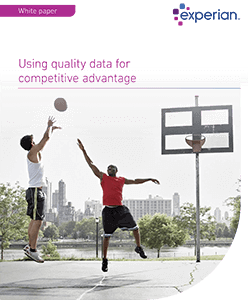- Products

Enjoy a free 30-day trial of our
data validation software.Experience the power of trusted data
solutions today, no credit card required! - Solutions

Enjoy a free 30-day trial of our
data validation software.Experience the power of trusted data
solutions today, no credit card required! - Partners

Enjoy a free 30-day trial of our
data validation software.Experience the power of trusted data
solutions today, no credit card required! - Learn more
- Pricing
- Contact Us
Using quality data for competitive advantage
Companies are always looking for opportunities to provide greater value to their customers. But in order to stay ahead of their competitors, they also need to increase margin, reduce attrition, and improve operational productivity.
Any company intending to achieve and maintain a competitive advantage must rely on fundamental access to superior resources. And in this digital day and age, one of these key resources is data. No matter the industry, any organization seeking to grow revenue, increase productivity, and improve customer service must consider the dependency of these objectives on good data.
Competitive advantage and the dependence on data
Establishing competitive advantage implies focusing on specific areas of competition and determining how improvements will influence market perception.
While there are many areas that can benefit from this type of focus, we look at three areas of focus for competitive advantage:
Revenue generation and growth
Revenue growth is driven by a combination of strategic best practices:
The competitive advantage for revenue growth depends on accurate assessment of current performance in these areas, identification of the best opportunities for optimization, and clearly-defined performance metrics.
Some ways for gaining competitive advantage include:
Yet accuracy in these metrics is impacted by data errors. Unfortunately, corresponding results can be skewed if one cannot accurately measure the current levels of performance or evidence of improvement. Missing customer information, incorrect location data, errors in demographic values, or missed expectations for inventory and supplier data are common across many organizations. Flagging data errors and applying governed practices in data correction will lift your company above the pack when it comes to increasing revenue.
Operational efficiency
Operational efficiency describes the activities performed to increase effectiveness while reducing investment or reliance on resources. There are many aspects of operational efficiency, including:
Organizations depend on accurate information regarding customer identities, customer addresses, and vendor and supplier information to gain a competitive edge. Delivery costs can be reduced by eliminating redundant mailings, increasing accuracy of target addresses, and meeting postal standards. Accurate and current information regarding allocation of assets and proximity analysis of service crews to customer locations reduces time for repairs while maintaining high asset utilization.
Customer service excellence
At a time when outbound calls are limited due to “do not call” lists and the typical inbound customer call is a complaint, being able to increase customer satisfaction opens new opportunities for growing revenue by turning an unsatisfied customer into a satisfied one! Excellent customer service means:
In order to do this, the service representatives must understand the company’s relationship with the customer by having access to a full and accurate view of interactions. In turn, this same accurate data helps maintain clear communication through a variety of channels, such as web, phone, and physical branch offices.
Data quality—the common denominator
There are recurring themes in each of these four areas for establishing competitive advantage: accuracy, completeness, timeliness, and currency of the underlying data. Simply looking at the quality dimensions of customer and location data, understanding what types of errors can occur, and instituting methods for remediation can contribute to your company’s efforts in establishing competitive advantage.
What is data quality?
What is high quality data? If you were to presume that all data values were entered, computed, or imported in a “pristine state,” you’d probably be disappointed. It is relatively infrequent that every record in every dataset meets all user expectations. Most datasets originate through data entry processes in which real (and fallible) people are transcribing data into systems, which have little or no validation at entry. There is also a lot of data that exists in forms that are not immediately suited to typical business applications, such as text documents, presentations, spreadsheets, and web pages.
The disparity of sources, input channels, and workflows all open up the potential for data errors. Examples include:
Because of the variety of methods for introduction, the potential for problems is multiplied. Any of the problems enumerated here (and even a combination of them!) can appear in almost any collection of data.
Implementing data quality
While there are many approaches for creating an environment that limits the introduction of data errors as a way of improving data quality, there are two data quality improvement techniques that can be applied to provide immediate benefits:
Data validation or data cleansing – transforming a mistaken data value into a form that meets user expectations such as parsing, standardization, and data enrichment. Data validation or cleansing then applies transformation rules in order to correct names or addresses, eliminate extraneous and/or meaningless data, and ensure standard formats.
Data enrichment – performing address standardization and correction, enriching demographic data, and incorporating historical data from multiple sources. Data enrichment will ultimately reduce delivery costs, provide a full view of the customer, and enhance business decisions intended to improve competitiveness
Competitive advantage emerges in organizations that undertake best practices across a broad swath of disciplines. Our review of key competitive advantage areas shows a shared dependence on high quality data and that instituting data cleansing and data enrichment initiatives can address identified shortcomings Therefore, we can reasonably suggest that good data management practices, such as ensuring data quality and governed data cleansing, will ultimately lead to a measurable improvement of a company’s competitive advantages.

